
Features
Associations
Business
The big 4-0
Ground Water Canada marks its 40th birthday with a trip through the decades.
June 17, 2014 By Colleen Cross
Ground Water Canada, which began life in 1974 as Canadian Water Well, was first published by Agri-book, then taken over by Peter Darbishire and Peter Phillips, who formed AIS Communications. Annex Publishing & Printing purchased Ground Water Canada and other magazines owned by the pair in 2004.
Ground Water Canada, which began life in 1974 as Canadian Water Well, was first published by Agri-book, then taken over by Peter Darbishire and Peter Phillips, who formed AIS Communications. Annex Publishing & Printing purchased Ground Water Canada and other magazines owned by the pair in 2004.
 |
|
| Representatives of each province’s association discuss drilling acts and licensing programs at the Atlantic meeting in 1978. From left to right: Joe Saab, president, New Brunswick; Eugene Veinotte, vice-president, Nova Scotia; Wayne Chisholm, president, Nova Scotia; Jim Tucker, president, Newfoundland; and Watson MacDonald, president, Prince Edward Island. Advertisement
|
Phillips and Darbishire, along with editors Elinor Humphries, Scott Hill, Craig Power, Chris Skalkos and Laura Aiken, have covered the industry over the years.
A look back through 40 years of Ground Water Canada reminds us that despite the weighty concerns of ground water contamination, well-drilling and inspection techniques, worksite safety, water quality, certification, unification among provinces and geothermal technology, people are still at the centre of the ground water industry and its development.
Andreas “Andy” Knelsen, first president of the Canadian Water Well Association (later to become the Canadian Ground Water Association), showed concern with two facets of the water well driller: professionalism and image. On the one hand, drillers are concerned about raising and maintaining standards within industry ranks, he wrote in his initial address in 1978. On the other, they are mindful of the impression they present to the public.
Through four decades of coverage, education has been a constant priority: education for water well drillers and technicians from within the ranks, and education of all levels of government and the general public about the role of the water well driller and importance of caring for ground water and private wells.
Here is a four-decade “dip into the well” of ground water history through our pages in honour of Ground Water Canada’s 40 years of proud service to our readers who protect and provide a resource no human can live without.
The early years
A feature on Tillsonburg Pipe and Supply Company, which later became Wellmaster Pipe and Supply, reminded readers of the first meeting of the Ontario Water Well Association, provincial forerunner to the Canadian Water Well Association (CWWA), which was hosted by the company on June 1, 1952. That meeting saw more than 100 drillers from the province meet to organize the provincial association, listen to speakers and take in a drilling demonstration by the Bucyrus-Erie Company of Milwaukee, Wis. From that early date, the OWWA aimed to abolish a provincial license fee on drillers. Wilfred L. Fields of St. Catharines was elected president.
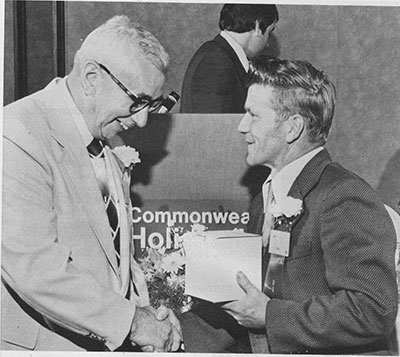 |
|
| Norman Faulkner, founder, past president and now honourary life member of the Ontario Ground Water Association, accepts gifts from James Wilson (R), association president from 1977 to 78 at at the 1977 convention.
|
On Dec. 19, 1962, the Canadian Water Well Contractors Association was officially formed. In June of 1974 it dissolved due to provincial and federal requirements and was re-formed as the Ontario Water Well Association (OWWA). According to association records, interest at that time was building among the provinces to form a national association.
In June 1977, the Canadian Water Well Association (CWWA) was re-instituted minus the word Contractor.
Andy Knelsen of Barrie, Ont., elected first CWWA president in April 1978, told Canadian Water Well in June of that year that “professionalism must be encouraged among Canadian drillers” and that one key objective of the association was to raise public awareness of the role of the water-well driller. Knelsen also said there was work to be done on the image of the driller. “There has been a tendency for an image to build of the driller as a man concerned only with the number of feet drilled. . . . We have to educate the clients that water comes from aquifers and that the depth at which this water can be found may vary dramatically.”
Members from seven provinces made up the original national association: British Columbia, Alberta, Saskatchewan, Manitoba, Ontario, New Brunswick and Nova Scotia. Newfoundland, Prince Edward Island and Quebec joined later.
In June of 1979, Canadian Water Well profiled Norman Faulkner, who started Faulkner Well Drilling in 1934. In 1946, Faulkner bought three used, track-mounted drill rigs from Steep Rock Iron Mines in Northern Ontario and his first brand-new rig in 1953. By 1958 he had three new churn drill rigs, recalled son and then-owner of the company Jim Faulkner, who said “Faulkner Drilling probably accounted for about half the wells drilled in this part of southern Ontario.”
Uniroyal and Dom-X, suppliers of the ABS plastic compound, predicted a surge in well casings made from the compound, already in wide use in the U.S.
With increasing movement of people to rural areas and the advent of appliances such as the automatic washing machine and changes in water-use habits, water conditioning was in high demand and seen as a way for drillers to diversify.
In the summer of 1978, Durl Hopper of Seaforth, Ont., was surprised to find the capability of the well his company was drilling measured 980 gallons per minute, nearly double the 500 the town was expected to produce.
Canadian Groundwater Industries of Lloydminster, Sask., was reported to be providing an inspection service using a small TV camera and closed-circuit screen.
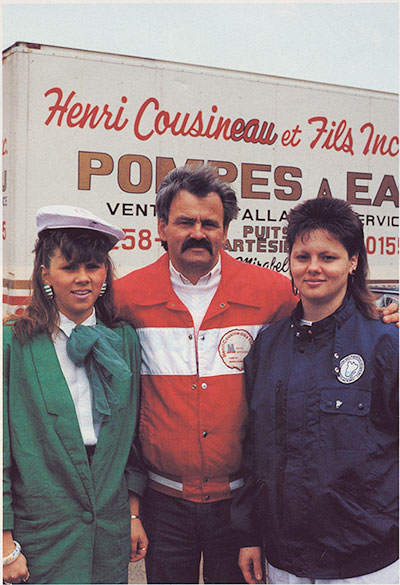 |
|
| Claude Cousineau and daughters Marie-Claude and Patricia of Henri Cousineau & Fils were profiled in the June 1989 edition of Canadian Water Well
|
University of Guelph professor J.B. Robinson anticipated nitrates would reach wells due to overuse of fertilizer. “Farmers should be educated in the effect of excess manure on water quality,” Robinson said in the article. The issue would resurface repeatedly and as late as spring 2014, when Rachel Beavins Tracy detailed a decade-long Canadian study that offered solutions to the human health hazard.
An August of 1979 feature entitled “Safety on the drill site” explored electrical hazards and natural gas pockets, noting the Ontario Workmen’s Compensation Board paid out $71 million in medical aid and other benefits to some 16,000 victims of lost-time injuries.
In August of 1979, the Barber Dual 12-24 came on the scene, boasting a Cummins diesel engine with 290 horsepower and weight of 45,000 pounds.
Overall, in 1979 Canadian manufacturers of mobile drill rigs seemed pleased by a change in status for imported rigs by Revenue Canada under the provisions of Section 6 of the Customs Tariff, “although the industry was wary of the effect it may have on the industry generally.” The provision changed the status of mobile drill rigs to “class-or-kind” and subjected them to 15 per cent duty.
The Quebec Water Well Drillers Association (QWWDA) was re-launched after being inactive due to various problems. “One of the current hot topics . . . is the new Quebec zoning law which limits the use of agricultural land for other purposes. Walter Oes, QWWDA director, said “this has cut the workload of some drillers in the province by 50 per cent.”
The 1980s
The Canadian Water and Wastewater Association was founded in November 1986 to provide a national voice for owners of municipal water and wastewater systems.
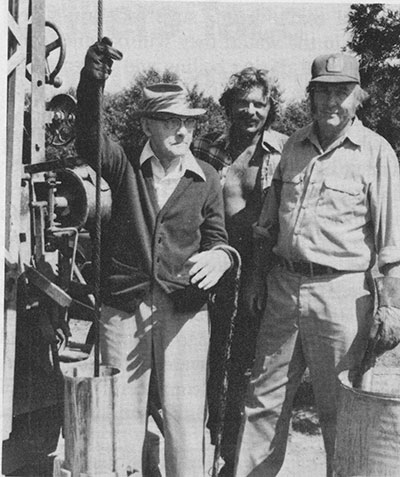 |
|
| Three of the four generations of the Fields family get together on a site near St. Catharines in 1978. Marshall Field, centre, was drilling this well near the edge of Lake Ontario and had just brought in water, when his father, Ray, right, and grandfather Wilfred, left, visited the site.
|
In January, 1989, Elinor Humphries, editor of the magazine, expressed disappointment that the British Columbia Water Well Drilling Association, which was calling for mandatory certification of drillers in the well-drilling trade, was told by the minister of the environment it would be necessary to get approval from all well drilling contractors and change the existing Water Act.
Well driller Theo Gerrits said in a January 1989 profile that he advocated educating his customers. In many cases, he said, customers read the book on water wells published by Environment Ontario (now the Ministry of the Environment), before they call him. “I think it’s good!” he said. “They know what questions to ask. If they haven’t seen the book, I make sure to give them one.”
The feature “Weak well and good water service” gave readers technical information on how to meet high demand from households with multiple bathrooms and heavy-water-use appliances. “Here is an idea,” said Don Radford of Goulds Pumps. “Let’s install a 10 gpm pump. . . . If we consider today’s energy saver fixtures that restrict the flow rate at 2-1/2 to 3 gpm each, then we could run several fixtures at once.”
Acushnet Rubber Division developed an elastomer formulated to impart no taste or odour to drinking water for use in storage tank diaphragms of well water accumulators and reverse-osmosis filter systems.
By September of 1989, international projects were frequenting the magazine’s pages. Ingersoll-Rand Canada supplied three mobile water well drilling rigs, tools and training to a state-owned provider of drinking water to rural Angola.
Federal government liaison committee members Bill Morrison, Wayne MacRae, Lock Gray and Maurice Lewis met Dennis Davis of Inland Waters to discuss mutual concerns and ways the association could work with government.
The 1990s
A January 1990 global ground water update told readers about a new telemetry application developed in the San Joaquin Valley of California to monitor levels of ground water contaminated with trichloroethylene and predict which underground route toxic plumes will take.
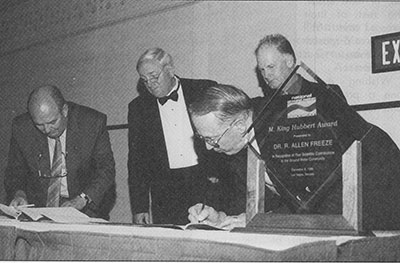 |
|
| Graeme Wakeling, executive officer, Australian Drilling Industry Association; John Schmitt, president, NGWA, in 1996; Maurice Lewis, secretary-manager, CGWA; and Martin Hammond, president, CGWA, sign mutual co-operation agreements among the three organizations in December 1996.
|
In April of 1990, Canadian Water Well reported that pump installer licensing was implemented in 1989 under Ontario Regulation 612/84 for those involved in the installation of pumps and pumping equipment in water wells. Contractors became required to obtain a Well Contractor Licence and employees actually performing the work were then required to have a Well Technician Licence, Class 4 (Pump Installation). The other three classes have been required since 1986. “During 1989 approximately 400 new well contractor licenses and 1,000 new well technician licences were issued.”
In April of 1991, researchers were hoping that a naturally occurring phenomenon could be used to reduce nitrate levels in ground water. The University of Guelph’s Eric Beauchamp and a team from the department of land resource science were said to be studying ways to estimate denitrfication – conversion of nitrate into nitrogen gas – in soil. Denitrification occurs by the action of bacteria in water-saturated soil. The team aimed to create a model for predicting within a 25 per cent certainty level of denitrification by means of temperature, degree of water saturation of the soil, nitrate concentration, availability of organic carbon substrate and availability of oxygen.
In June of 1991, Canadian Water Well reported the effects on surrounding ground water of a tire fire in Hagersville, Ont., in which nearly 14 million tires were burned or melted down. An article detailed progress of its cleanup and explored the extent to which poorly managed domestic wells are also culprits in contamination.
Resource and Conservation Recovery Act’s underground storage tank regulations were forcing difficult business decisions for well drillers and suggested tank owners evaluate their legal liability for both personal injury and property damage in the event a tank leaks.
A 1992 article focusing on computers – eight years ahead of Y2K – offered readers ways to ensure their hardware wasn’t vulnerable to power problems, including surge suppressors, voltage regulators and line conditioners, and standby and uninterruptible power systems.
Water treatment was still seen as a worthwhile sideline in a profile on MacDonald and Sons of Montreal, a company successfully providing this service. Gord Smith, the company’s vice-president, told Canadian Water Well that the biggest hurdle to expansion was lack of knowledge by dealers, but he also shared that the company had experienced a 30 per cent increase on its water treatment side. “It’s a fascinating and frustrating field,” he said. “You’re competing with guys who are vacuum cleaner salesmen and water treatment experts.”
Westvaco introduced the Bio-Nuchar wood-based activated carbon to Canada. Westvaco and PICA had co-operated on the use of special wood-based carbons in biological treatment processes for potable water.
In 1992, the CWWA published its Guidelines for Water Well Construction, intended to provide a basic minimum standard across Canada.
In the June of 1993 CWWA newsletter, the Industry Qualification and Certification committee, chaired by Maurice Lewis, recommended to the Canadian Council of Directors of Apprenticeship that interprovincial training and reciprocal recognition of trade designation be put in place so that every province will have journeymen drillers under which trainees can apprentice.
A technical feature on hydraulic fracturing, or hydra-fracking, described the process borrowed from the oil well industry that offers an alternative to the unpredictability of surging or dynamiting.
A September of 1993 feature discussed the pros and cons of air strippers as tools for the removal of volatile organic contaminants from ground water. “Strippers pass contaminated water through a tower through which a large volume of air is blown,” said the article, but they are often plagued with operating problems.
The Drilling and Blasting Training Centre of Sir Sandford Fleming College’s School of Natural Resources in Lindsay, Ont., graduated the first class of its pump systems apprenticeship program.
Ground Water Canada reported the Canadian Association of Pump Manufacturers was concerned about the costs of certification to meet the requirements of the proposed Health Canada legislation standards, NSF61, for treatment devices, treatment additives and system components.
The Canadian Ground Water Association, the new incarnation of the CWWA, signed mutual co-operation agreement with the National Ground Water Association at the NWGA annual convention in Las Vegas in December 1996.
The June 1997 CGWA newsletter described an extensive letter-writing campaign that began in 1996 to voice its concerns that improper abandonment of test holes by the oil and mineral exploration industry could provide a direct conduit for contaminants to enter ground water.
Among new products featured was a high-resolution, high-sensitivity underwater camera, which boasted excellent colour reproduction. It was designed for water well inspection but applicable for cased or uncased borehole inspections.
The 2000s
In June of 2000, engineer Brian Beatty, then-director of the scientific and engineering division of the OGWA, predicted a “paradigm shift” in the use of water. “As municipalities start to finance their own water supplies and infrastructure, we will become a more conservative society. Governments will adopt efficiency standards for household plumbing fixtures. Leaks in the distribution piping will be reduced. Society will tolerate brown lawns, and we will learn to squeeze more out of the existing supply. . . Water use efficiency and reduced consumption, however, will not offset the increased demand of a growing urban population.” Beatty concluded, “Ground water will be brought into the mainstream of planning in communities where abundant supplies are available.”
E-commerce was first mentioned in CanWell 2000 and highlights such as web catalogues were touted as a convenience for purchasers.
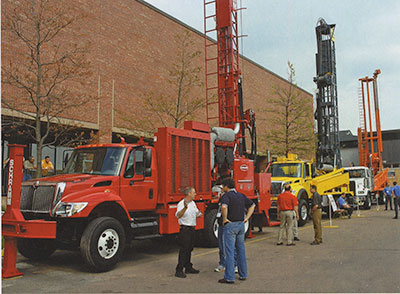 |
|
| Brand new water well drilling rigs were on display to greet visitors in front of the show hotel, the Delta Prince Edward for CanWell 2006 in Charlottetown. |
In a June, 2001, editorial, managing editor Peter Darbishire said three questions were being asked following the 2000 E. coli contamination of the water supply at Walkerton, Ont., which led to seven deaths and sickened more than 2,300: “Is our ground water safe? What contaminants are harmful? How can we protect our supply?” and stressed the importance of the industry being “seen and heard doing the right thing in protecting this most valuable resource.”
The CGWA, the NGWA, University of Waterloo, and Red Deer College hosted a joint conference on hydrogeology in Banff, Alta., for contractors, drillers, scientists and engineers.
Wayne MacRae, then-executive director of the CGWA, pointed to three ongoing issues in the industry: communication among provinces and the organization’s Canadian office; finances; and training and certification.
Ground Water Canada offered a history of ground water that went right back to the Archimedes’ screw in its summer 2012 issue.
In April 2013, bankruptcy claimed the life of the Canadian Ground Water Association, with the Canadian GeoExchange Coalition the prime indebted after a three-year battle. The bankruptcy leaves “a wound for two industries,” said editor Laura Aiken in a June 2013 editorial, noting that it “doesn’t need to mean the end of a national association. It’s simply the end of a corporate number.”
We hope you’ve enjoyed this look back at an eventful first 40 years. The team at Ground Water Canada is looking foward to ringing in the changes and providing information and perspective to this vibrant and growing industry for the next 40 and beyond.
Print this page